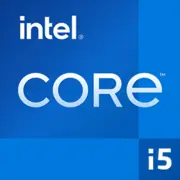Intel Core i5-13600T

Intel Core i5-13600T: Recensione completa del processore per sistemi a basso consumo energetico
Marzo 2025
Caratteristiche principali: Architettura ibrida e equilibrio
Il processore Intel Core i5-13600T, basato sull’architettura Raptor Lake (nome in codice), combina alte prestazioni e efficienza energetica. Si tratta di una CPU ibrida con 14 core (6 core ad alte prestazioni P-cores e 8 core ad alta efficienza E-cores) e 20 thread. Il processo tecnologico Intel 7 (precedentemente 10 nm Enhanced SuperFin) ottimizza il calore e il consumo energetico.
Caratteristiche principali:
- Architettura ibrida: I P-cores (fino a 4.8 GHz in Turbo Boost) sono dedicati ai compiti impegnativi, mentre gli E-cores (fino a 3.6 GHz) gestiscono i processi in background.
- Cache L3: 24 MB di Smart Cache accelerano l'elaborazione dei dati in scenari multithread.
- Grafica integrata: Intel UHD Graphics 770 supporta 4K a 60 Hz e decodifica AV1.
- TDP di 35 W: Ideale per PC compatti e sistemi con raffreddamento passivo.
Prestazioni:
- Geekbench 6: 2387 (Single-Core), 12509 (Multi-Core).
- Nei test di Cinebench R23: ~1450 punti (Single), ~13500 (Multi).
- Esempi reali: Rendering in Blender fino al 20% più veloce rispetto all’i5-12600T, e nei giochi (ad esempio, Cyberpunk 2077 a impostazioni basse) stabilità di 40-50 FPS attraverso iGPU.
Schede madri compatibili: Socket LGA 1700 e chipset
Il processore utilizza il socket LGA 1700, compatibile con i chipset delle serie 600 e 700:
- B760/H770: Ottimali per la maggior parte degli utenti. Supportano PCIe 5.0 x16 e DDR5-5600. Esempi: ASUS TUF Gaming B760-PLUS ($150-180).
- Z790: Per gli appassionati che desiderano overcloccare la memoria. Prezzo: a partire da $200 (MSI PRO Z790-A).
Caratteristiche da considerare:
- Controllare il supporto per DDR4/DDR5 (non tutte le schede sono universali).
- Per assemblaggi compatti — formati Mini-ITX (ad esempio, ASRock Z790M-ITX).
- Potrebbe essere necessario un aggiornamento del BIOS per le schede madri più vecchie della serie 600.
Memoria: DDR4 vs DDR5
L’i5-13600T supporta entrambi i tipologie di memoria, ma con limitazioni:
- DDR4-3200: Opzione economica. Adatta per attività d'ufficio (kit da 32 GB — $70-90).
- DDR5-5600: Raccomandata per giochi e compiti professionali. Le latenze sono diminuite con l'uscita dei nuovi moduli (32 GB — $110-130).
Consiglio: Nei giochi, la differenza tra DDR4 e DDR5 è dell’8-12% (ad esempio, Shadow of the Tomb Raider), ma per il rendering DDR5 è avvantaggiata per la larghezza di banda.
Alimentatori: Minimo 500 W
Nonostante il TDP di 35 W, l'uso di una scheda video dedicata (ad esempio, NVIDIA RTX 4060) richiederà un'unità di alimentazione da 500-600 W.
- Senza grafica dedicata: Sono sufficienti 300-400 W (Be Quiet! Pure Power 11 400W, $60).
- Con GPU: Si raccomandano modelli certificati 80 Plus Gold (Corsair RM650x, $100).
Importante: Evitare alimentatori economici — una tensione instabile può danneggiare i componenti.
Pro e contro
Pro:
- Efficienza energetica: Consuma fino al 40% in meno rispetto all’i5-13600K.
- Versatilità: Adatto per workstation e media center.
- Funzionamento fresco: Anche sotto carico, la temperatura raramente supera i 65°C.
Contro:
- Overclocking limitato: Il moltiplicatore è bloccato (eccetto per i chipset Z790).
- Prezzo: $260-280 (marzo 2025) — più costoso dell’AMD Ryzen 5 7600 ($220).
Scenari d'uso
1. Attività d'ufficio: Multitasking con decine di schede + streaming video.
2. Media center: Supporto HDMI 2.1 e decodifica AV1 per Netflix 4K.
3. Attività lavorative: Montaggio video in Premiere Pro, modellazione 3D (ottimizzazione tramite Quick Sync).
4. Gaming: Con una GPU dedicata (RTX 4060 Ti) — 1080p Ultra in Elden Ring (60 FPS).
Confronto con la concorrenza
- AMD Ryzen 5 7600: Più economico ($220), ma 6 core contro 14 di Intel. Nelle attività multithread, l’i5-13600T è più veloce del 25%.
- Apple M2 (per PC): Migliore efficienza energetica, ma compatibilità limitata con software Windows.
Consigli pratici per l'assemblaggio
1. Raffreddamento: Sufficiente un dissipatore a torre (DeepCool AK400, $35).
2. Storage: SSD NVMe (Samsung 980 Pro 1TB, $90) per la massima velocità.
3. Case: Per mini-PC — Fractal Design Node 304 ($110).
Conclusione finale: A chi si adatta l’i5-13600T?
Questo processore è la scelta ideale per:
- Appassionati di PC compatti: Assemblaggi Mini-ITX a basso rumore.
- Utenti d'ufficio: Affidabilità e risparmio energetico.
- Content creator: Rendering veloce senza sovraccarico per un i7.
Se non hai bisogno del massimo FPS nei giochi, ma desideri un equilibrio tra prestazioni e consumo energetico, l’i5-13600T sarà la soluzione ottimale. Tuttavia, per budget ristretti, vale la pena considerare l’AMD Ryzen 5 7600.
I prezzi sono aggiornati a marzo 2025. Tutti i marchi e i prodotti menzionati sono marchi registrati.
Di base
Specifiche della CPU
Specifiche della memoria
Specifiche della GPU
Varie
Classifiche
Rispetto ad altre CPU
Condividi sui social media
Oppure linkaci
<a href="https://cputronic.com/it/cpu/intel-core-i5-13600t" target="_blank">Intel Core i5-13600T</a>